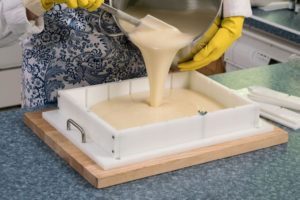By now you know that I can really wax poetic about vinegar: It cleans windows, tenderizes meat, brightens salads , neutralizes odors and even softens your laundry! And if you’re still looking for creative ways to use up your summer harvest (and you just can’t bear the sight of your pressure canner any longer), look no further. It’s vinegar to the rescue once again!
, neutralizes odors and even softens your laundry! And if you’re still looking for creative ways to use up your summer harvest (and you just can’t bear the sight of your pressure canner any longer), look no further. It’s vinegar to the rescue once again!
Infused vinegars are a superb way to capture the fresh and clean flavors of fruits, vegetables and herbs all winter long, when your taste buds are screaming for a diversion. And though you may struggle to use up some of the things you’ve canned this season (40 jars of pickled watermelon rind? What were you thinking?), you’ll never get bored with vinegar. Berry, peach and nectarine varieties are delicious drizzled over artisan salads. Herb vinegars are nice for salads, too, and for adding to pots of beans, soups, and stews to brighten and intensify their flavor without adding more salt. Or play around with the trend of working vinegar into elegant desserts. How about a dish of home-churned bittersweet chocolate ice cream drizzled with a berry-infused balsamic? Doesn’t that just make your toes tingle?
Things get even more indulgent when you pair infused vinegars with flavorful oils. Just consider the flavor combinations in your favorite recipes and go wild. How about tangerine vinegar and Szechuan pepper oil over a cold salad of snow peas, carrots, bell peppers and rice noodles? Or whisk up a zesty sandwich dressing by blending sun-dried tomato oil with basil vinegar. A lemon oil and oregano vinegar combo makes a savory and tenderizing marinade for chicken, or a simple dressing for a fresh Greek salad. Heck, you could build an entire hors d’oeuvres spread around a stack of warm crostini, a log of goat cheese and an assortment of infused oils and vinegars. Still not a believer? Go sear yourself a steak in garlic oil and deglaze the pan with Herbes de Provence vinegar. I rest my case.
The recipes I’m providing here are only guidelines — get creative and swap in different types of vinegars and your favorite herbs and fruits. A general rule of thumb is to use approximately equal measures of fruit and vinegar, and a 1:2 ratio of loosely packed herb leaves and vinegar. Using dried herbs? That’s 1/2 cup leaves to 2 cups vinegar. Herbal vinegars are a cinch: simply pour vinegar over the herbs to steep. For fruit vinegars, you’ll want to heat all your ingredients together before steeping to extract every luscious bit of flavor.
A note on safety: Thankfully, vinegar is too acidic for botulism to pose a threat. That being said, other pathogens that live on fresh produce can be an issue if you’re not careful. Sterilize your jars beforehand, and wash produce thoroughly. Only use herbs and fruit that are free of blemishes and bruises, and keep finished vinegars in the refrigerator.
And don’t forget to double or triple the recipe to make enough to share! Bottles of infused vinegar are downright decorative, so they make great hostess, housewarming or holiday gifts.
Elderberry Vinegar (Blueberries also work well)
(Try this gorgeous purple concoction paired with a mild oil and drizzled over some tender greens and edible flowers, like nasturtiums.)
2-1/4 cups elderberries
2 tablespoons honey
2 cups red wine vinegar
Use a fork to lightly mash the berries. Place all the ingredients in a heavy-bottomed, nonreactive saucepot over low heat. Once the mixture has started to simmer, cook it for an additional 10 minutes, stirring occasionally to prevent the fruit from burning. Pour the mixture into a glass jar with a screw-on lid and store in a cool, dark place for three weeks. Using a fine mesh strainer lined with a coffee filter, separate out the berries. Use a wooden spoon to push on them and extract as much juice as possible. Pour into pretty bottles and garnish with a few whole berries, if you like.
Rosemary Vinegar (Basil also works well)
(You’ll never make chicken salad with plain old white vinegar again.)
1 cup loosely packed rosemary leaves (you can also leave them on the stem for easier removal)
2 cups white wine vinegar
Put the leaves into a screw-top jar. Using a spoon, bruise them up a bit to release more of the essential oils. Pour the vinegar over the herbs, seal the jar and let it steep for about three weeks in a cool, dark place. Shake the jar once or twice weekly and check the flavor periodically for strength. Once you have it where you like it, strain out the herbs, pour the vinegar into decorative bottles and seal.
Copyright 2010, MaryJane Butters.
Distributed by United Feature Syndicate, Inc.

































